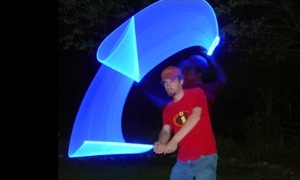A magazine where the digital world meets the real world.
On the web
- Home
- Browse by date
- Browse by topic
- Enter the maze
- Follow our blog
- Follow us on Twitter
- Resources for teachers
- Subscribe
In print
What is cs4fn?
- About us
- Contact us
- Partners
- Privacy and cookies
- Copyright and contributions
- Links to other fun sites
- Complete our questionnaire, give us feedback
Search:
The virtual Jedi

A virtual reality animation is giving users an experience that was previously only available a long time ago in a galaxy far, far away. Josh Holtrop, a graduate of Calvin College in the USA, has constructed a Jedi training environment inspired by the scene from Star Wars in which Luke Skywalker goes up against a hovering droid that shoots laser beams at him. Fortunately you don’t have to be blindfolded in the virtual reality version, like Luke was in the movie. All you need to wear over your eyes is a pair of goggles with screens inside.
When you’re wearing the goggles, it’s as though you’re encased in a cylinder with rough metal walls. A bumpy metallic sphere floats in front of the glowing blade of your lightsabre – which in the real world is a toy version with a blue light and whooshy sound effects. The sphere in your goggles spins around, shooting yellow pellets of light toward you as it does. It’s up to you to bring your weapon around and deflect each menacing pulse away before it hits you. If you do, you get a point. If you don’t, your vision fills with yellow and you lose one of your ten lives.
Tracking movement with magnetism
It takes more than just some fancy goggles to make the Jedi trainer work, though. A computer tracks your movement in order to translate your position into the game. How does it know where you are? Because the whole time you’re playing the game, you’re also wandering through a magnetic field. The field comes from a small box on the ceiling above you and stretches for about a metre and a half in all directions. Sixty times every second, sensors attached to the headset and lightsabre check their position in the magnetic field and send that information to the computer. As you move your head and your sabre the sensors relay their position, and the view in your goggles changes. What’s more, each of your eyes receives a slightly different view, just like in real life, creating the feeling of a 3D environment.

Once the sensors have gathered all the information, it’s up to the software to create and animate the virtual 3D world – from the big cylinder you’re standing in to the tiny spheres the droid shoots at you. It controls the behaviour of the droid, too, making it move semi-randomly and become a tougher opponent as you go through the levels. Most users seem to get the hang of it pretty quickly. "Most of them take about two minutes to get used to the environment. Once they start using it, they get better at the game. Everybody's bad at it the first sixty seconds," Josh says. "My mother actually has the highest score for a beginner."
The atom smasher
Much as every Jedi apprentice needs to find a way to train, there are uses for Josh’s system beyond gaming too. Another student, Jess Vriesma, wrote a program for the system that he calls the “atom smasher”. Instead of a helmet and lightsabre, each sensor represents a virtual atom. If the user guides the two atoms together, a bond forms between them. Two new atoms then appear, which the user can then add to the existing structure. By doing this over and over, you can build virtual molecules. Eventually, the researchers at Calvin College hope to build a system that lets you ‘zoom in’ to the molecule to the point where you could actually walk round inside it.
The team have also just bought themselves a shiny new magnetic field generator, one that lets them generate a field that’s almost nine metres across. That’s big enough for two scientists to walk round the same molecule together. Or, of course, two budding Jedi to spar against one another.


